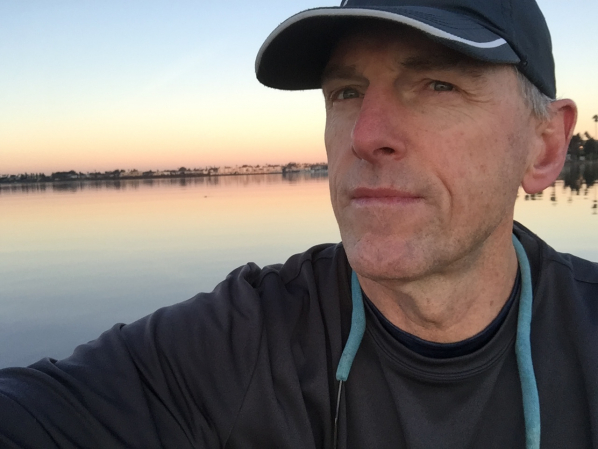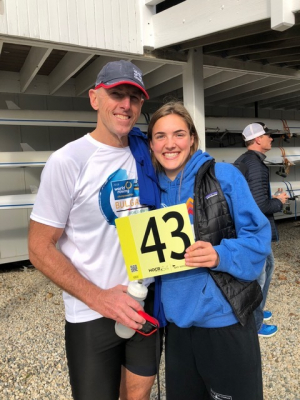10 Questions with Tom Darling

Thomas Darling is the Director of Para Rowing for USRowing. His job is to identify and develop nine para athletes to race in the Paralympics. Tom is a three time Olympian: 1980 (boycott), 1984 (Silver Medal, Men’s 8+) and 1988 (5th, Men’s 4+). He graduated from Syracuse University in 1981 with a BA in Psychology and earned a MEd from Boston University 1991. In 2008 he started volunteering at Community Rowing in Newton, Massachusetts, with the Adaptive Rowing program and created the first Adaptive Indoor Rowing Championships (AIR-Cs) in 2009, and subsequently introduced para events at the CRASH-Bs. He was hired by USRowing as Director of Para Rowing in 2013.
When did you first hear the name Concept2 or try one of our products?
It was in the late 70s when Dick and Peter Dreissigacker first started Concept2 and produced the early carbon fiber oars. We used the first carbon fiber blades internationally in 1980 in the USA Men's Coxed Four. I liked the wooden Karlisch blades because they dropped in nicely, and the carbon fiber oars seemed so light and hard to control. I was convinced by the stroke of the boat, John Biglow, and Coach Peter Gardner to give the Concept2 blades a try. It was clear the lighter blades were the right way to go, especially at the end of a race when weight becomes a bigger factor. We switched to those and proceeded to win the Prince Philips Cup that year at the Royal Henley Regatta. I also raced in one of the early indoor rowing championships with the first Concept2 Model A ergometers.
Do you remember your first workout on a Concept2 machine? What did you think at first, and do you remember how you felt afterwards?
The early rowing ergometers were called the Gamut erg. It was a heavy machine that used a sweep handle arm on either the port or starboard side attached by cables to a flywheel. Resistance or load was regulated by a basket of weights that applied pressure on the flywheel using a break system (pad). The more weight in the basket the greater the resistance on the flywheel. The Concept2 Model A ergometers used a bicycle wheel with square plastic pieces in the spokes to produce wind resistance. Working against wind resistance felt more like the feel of water resistance against the hull in a boat, so the switch to Concept2 was a welcome change.
Which Concept2 products do you use and why have you chosen those products? How do they enhance your training?
I use them all: the oars, oarlocks, ergs, slides, and more recently, the SkiErg. I’ve chosen Concept2 products for their durability and superior design compared to other similar products on the market. They enhance my training for the same reasons, including the reproducibility between machines to compare to other individuals or teams using Concept2 products.
How do you incorporate Concept2 equipment into your programming?
As Director of Para Rowing for USRowing I deal closely with the staff at Concept2 regarding the equipment needs of our US Para Team. The staff at C2 have been incredibly helpful, supportive and responsive in the development of our oars and fixed seat design for our PR1 (Arms and Shoulder) and PR2 (Trunk and Arms) athletes' use.
 Tom Darling with his daughter Lia after his first place win at the 2018 Head Of The Charles® Regatta, Veteran 1x.
Tom Darling with his daughter Lia after his first place win at the 2018 Head Of The Charles® Regatta, Veteran 1x.
What types of athletes do you primarily work with?
Athletes with an impairment (para/adaptive athletes).
What’s your favorite/go-to workout?
I have a few favorite workouts depending on what I am trying to accomplish:
- 20k steady state at 16-18 spm (low and long) on regeneration/recovery days
- 4 x 10 min (4 minutes at 18 spm, 3 minutes at 22 spm, 2 minutes at 24 spm, 1 minute at 26 spm) for utilization or AT [aerobic threshold] work, or
- (45 seconds on at 30 spm/20 seconds off at 20 spm x 10) x 2 with 10 min rest between sets for speed, transportation or ATP/PC work.
Our para athletes race 2k, so I suggest they do the same volume and intensity as the able-bodied athletes.
We’d love to hear a quick story that involves Concept2 equipment—a motivational, funny, or learning moment.
It’s always rewarding to see improvement in our para athletes. One story I recall is when Concept2’s Mark McAndrew called me to say he heard of a rower who might be a good prospect for the Para Team. He proceeded to tell me about Blake Haxton from Ohio. Blake was a highly recruited rower in high school who, as a senior, had contracted a flesh eating bacteria. Blake fortunately survived this ordeal but lost both his legs and hip joints. Mark had heard about Blake and suggested I call him but to be careful how I approached him. It could be devastating for someone to come back to a sport that they competed at a high level, and try to adjust to a new way of competing in the same sport could be stressful. Nevertheless, I picked up the phone and called Blake and we had a great conversation. I simply told him that if he met our elite time standard on the erg at the upcoming CRASH-Bs that would help answer whether he could be a candidate for the US National Team. Blake took the challenge and came to CRASH-Bs that February and beat our elite standard by 15 seconds! Since that time, Blake has been our elite PR1 (Arms and Shoulder) athlete since 2013, finishing in the finals every year. Blake is an incredible athlete who is gaining speed every year and will hopefully make it to the medals stand in 2020.
What one piece of advice would you give to someone hopping on Concept2 equipment for the first time?
Don’t pull to hard! Remember, the arms are like ropes in rowing. Rowing is 90% legs and back. Let the body uncoil in a natural way that allows the major muscle groups to do the work. If you pull too hard with just the arms you will tire quickly and, without using the major muscles to their full advantage, you will not go as fast as you are capable of. In the PR1 (arms and Shoulder) and PR2 (trunk and arms) it’s an entirely different ball game. The arms must be trained like the legs to have strength and endurance.
What trainers or athletes do you look up to?
Mike Boyle of BodyByBoyle is one of the top trainers I look up to. Mike uses plyometric training to teach explosiveness and endurance in both pro and amateur athletes. One quote of Mike’s I like is, “Don’t run to get fit, get fit to run.” I feel the same applies to rowing. Athletes should “get fit to row, don’t row to get fit.” Igor Burdenko is another trainer I look up to. Igor believes in the six essential qualities to being a top athlete; an athlete needs to develop balance, coordination and flexibility in order to optimize endurance, speed and strength. He believes you have to have the first three in order to develop the last three. I also look up to Greg Hammond at Concept2. Greg is working with CrossFit athletes. It is important that we “compare notes” with other athletes in other sports to gain a better understanding of what it means to be an athlete. One of the best US National Team rowers/athletes of all time is the late Andy Sudduth. Andy won most of the major races: Grand Challenge Cup at Henley (with Harvard), the world indoor rowing championships in the 80s, the Head Of The Charles Regatta Champ 1x, World Championship medals in the 4+, 8+ and 1x. He was a great cyclist as well as runner. One of the best.
What or who inspires you to keep going?
My father always kept our family (6 kids) active while growing up. We hiked, fished, cross-country skied, skated, played ice hockey and tennis, canoed, and did various other sports. My father is 97 years old today and only stopped playing tennis three years ago. My mother, who passed away at 90 years old, always said in her later years, “as soon as you stop moving, you’re dead.” They both inspired me to keep moving.
